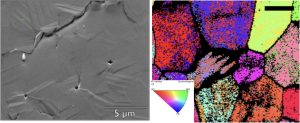
Ferroelastic toughening is an important yet elusive deformation mechanism in conventional thermal barrier coatings based on yttria stabilized zirconia. This mechanism, dependent on crystal symmetry, is also present in many electroceramics systems. The pheonomenon itself was identified many decades ago; however, we still lack a fundamental understanding of the controlling parameters necessary to effectively design tougher ceramics. We are striving to understand how microstructural effects such as grain size, orientation and phase constituency may impact the activation of ferroelasticity. To do this, we are using advanced microscopy techniques including electron backscatter diffraction, nanodiffraction, and small-scale mechanical cyclic loading configurations.
Relevant publications:
- Krogstad, J.A., M. Lepple, C.G. Levi. “Opportunities for Improved TBC Durability in the CeO2-TiO2-ZrO2 System.” Surf. Coat. Tech. 221 (2013) 44-52. DOI: 10.1016/j.surfcoat.2013.01.026.